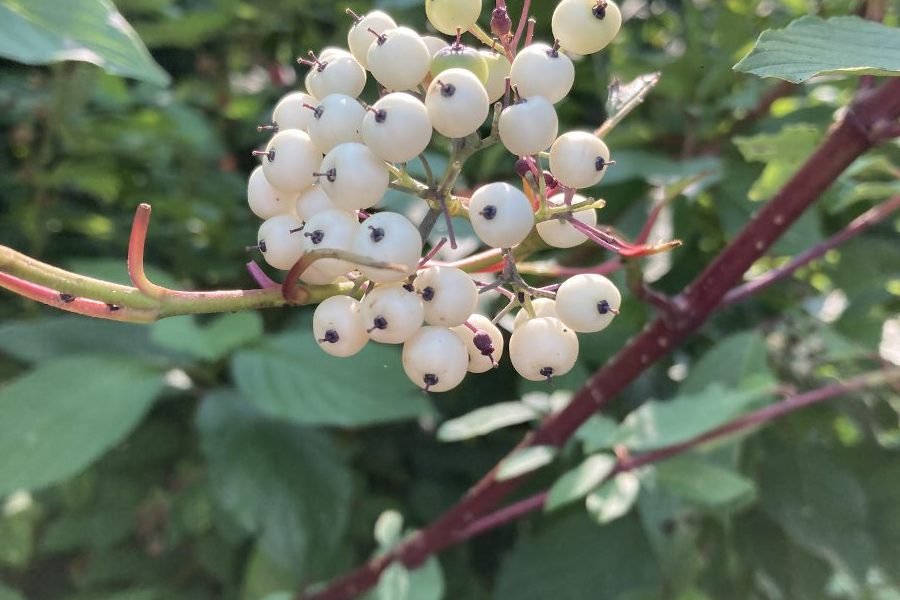Trail Time – Quiet Time of Summer
It’s a quiet time of summer on the Gunflint Trail — quiet, that is, except for human noises like construction and motorboats and loud bass music. The birds have quieted down; I think they are no longer raising babies or defending territory or seeking mates. I watch them busily catching flies, eating caterpillars and bugs, filling up and growing stronger for their upcoming long migratory flights. Happily, they still announce each morning’s sunrise. And there is at least one white-throated sparrow that likes to give out a call or two deep at night. It always makes me smile.
We enjoyed a prolonged spring this year — the singing seemed to last longer than usual and I wondered if many birds were raising two broods, since we had such excellent conditions this spring and early summer. I heard reports of two clutches of loon eggs on a couple of the lakes in the area. The veeries dominated the soundtrack here this season, with a very strong solo performance by the chestnut-sided warbler. One serenaded us from a chokecherry tree right beside our screen porch multiple times a day. It seems like the screen makes it harder for the birds to see us because we can be quite close and they don’t react. The red-eyed vireos also had starring roles in the symphony this year. The barred owl, due to reasons known only to him, decided to sit this year’s summer concert out. We heard his distinctive “who cooks for you?” in early spring, but not lately.
Sometimes the bird song becomes mere background noise to me, but there are a couple of birds that transport me to another plane whenever I hear them — a loon singing in the evening, echoing off the hills as darkness falls. And a thrush, singing in the deep woods, the song floating over the water as we paddle slowly by in a canoe. The thrush’s ascending song has such an haunting ethereal quality — it feels like it’s not totally from this earth. Upon hearing the sound, my mind instantly plays back images and feelings from Boundary Waters camping trips — quiet bays, tall trees, dark woods, very few humans and a sense of deep mystery. It feels like I’m listening in to something eternal and precious. It lasts just a moment, oh, but what a moment.
Right now the trees and shrubs are in their fulsome abundance of new green growth and berries and the hazelnuts are full grown. Soon they’ll disappear into the stomachs of hungry birds and animals. On our road, under a fruiting pin cherry tree, a little bear left a calling card. There were pin cherries scattered all over the ground, but it didn’t appear that the bear ate many raspberries right next to the tree. I wish I could enjoy a raspberry without feeling the compulsion to get a bucket and pick as many as I can. I don’t often follow that compulsion, but I feel guilty walking by an abundance of unpicked fruit. I imagine my frugal New England ancestors rolling in their graves as I stubbornly resist the ancient urge to pick, to glean, to harvest, to prepare for winter. Inevitably, with the help of Lars, I grudgingly give in, start picking and make a raspberry pie.
The red osier dogwood has small white berries now, but we don’t eat those, although I have read that they are edible. They are hardier than the soft fruits of the chokecherry and other berry trees and shrubs, and last well into the winter. Both songbirds and game birds eat the fruit and bear, beaver, rabbits, squirrels and small rodents eat the berries and the leaves. Moose browse the twigs and foliage. Many native Americans use red osier dogwood. The inner bark is scraped and smoked with a tobacco mixture for sacred pipe ceremonies. Infusions of the bark are traditionally used by Chippewa for medicinal purposes and to make dyes. The inner bark is used for tanning or drying animal hides. The branches can be woven into baskets.
On many of the dogwood leaves I noticed what looked like yellow and black caterpillars curled into circles. They are not caterpillars — they are sawfly larva. I assumed I should pick them off and destroy them — I thought they were pests and would damage the plant — but I read that adult sawflies are important pollinators and the larva are eaten by many birds and animals. I love investigating the life of a simple plant and learning of its value in this ecosystem. The boreal forest around us is a precious resource and the more I learn about it the more prone I am to live and let live with all my neighbors: plants, insects, animals and humans.
— Marcia Roepke











